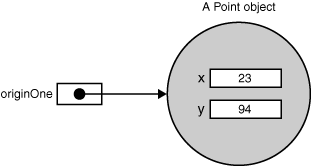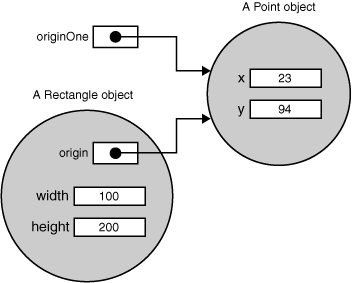Creating Objects
CreateObjectDemo program creates an object and assigns it to a variable:
Point originOne = new Point(23, 94); Rectangle rectOne = new Rectangle(originOne, 100, 200); Rectangle rectTwo = new Rectangle(50, 100);
Point class,
and the second and third lines each create an
object of the
Rectangle class.
Each of these statements has three parts (discussed in detail below):
- Declaration: The code set in bold are all variable declarations that associate a variable name with an object type.
- Instantiation: The new keyword is a Java operator that creates the object.
- Initialization: The new operator is followed by a call to a constructor, which initializes the new object.
Declaring a Variable to Refer to an Object
Previously, you learned that to declare a variable, you write:type name;
You can also declare a reference variable on its own line. For example:
Point originOne;
originOne like this, its value will be undetermined
until an object is actually created and assigned to it.
Simply declaring a reference variable does not create an object.
For that, you need to use the new operator,
as described in the next section. You must assign an object to originOne
before you use it in your code. Otherwise, you will get a compiler error.
A variable in this state, which currently references no object,
can be illustrated as follows (the variable name, originOne,
plus a reference pointing to nothing):
Instantiating a Class
The new operator instantiates a class by allocating memory for a new object and returning a reference to that memory. The new operator also invokes the object constructor.
Note: The phrase "instantiating a class" means the same thing as "creating an object." When you create an object, you are creating an "instance" of a class, therefore "instantiating" a class.
The new operator requires a single, postfix argument: a call to a constructor. The name of the constructor provides the name of the class to instantiate.
The new operator returns a reference to the object it created. This reference is usually assigned to a variable of the appropriate type, like:
Point originOne = new Point(23, 94);
int height = new Rectangle().height;
Initializing an Object
Here's the code for the Point class:
public class Point {
public int x = 0;
public int y = 0;
//constructor
public Point(int a, int b) {
x = a;
y = b;
}
}
Point originOne = new Point(23, 94);

public class Rectangle {
public int width = 0;
public int height = 0;
public Point origin;
// four constructors
public Rectangle() {
origin = new Point(0, 0);
}
public Rectangle(Point p) {
origin = p;
}
public Rectangle(int w, int h) {
origin = new Point(0, 0);
width = w;
height = h;
}
public Rectangle(Point p, int w, int h) {
origin = p;
width = w;
height = h;
}
// a method for moving the rectangle
public void move(int x, int y) {
origin.x = x;
origin.y = y;
}
// a method for computing the area of the rectangle
public int getArea() {
return width * height;
}
}
Rectangle rectOne = new Rectangle(originOne, 100, 200);
Rectangle's constructors that
initializes origin to originOne.
Also, the constructor sets width to 100 and
height to 200.
Now there are two references to the same Point object—
an object can have multiple references to it, as shown in the next figure:

Rectangle constructor that requires two
integer arguments, which provide the initial values for width
and height. If you inspect the code within the constructor,
you will see that it creates a new Point object whose x
and y values are initialized to 0:
Rectangle rectTwo = new Rectangle(50, 100);
Rectangle rect = new Rectangle();
Object constructor if the class has no other parent.
If the parent has no constructor (Object does have one), the compiler will reject the program.
